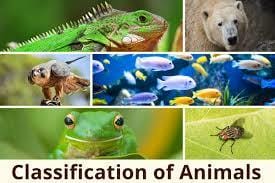How to classify plants and animals | Year 6 Science PDF Download
| Table of contents |

|
| Classification |

|
| Classifying animals |

|
| Classifying Plants |

|
| Classification of Microorganisms |

|
Classification
Classification in biology involves organizing living organisms into groups based on shared characteristics such as appearance and behavior. This helps in understanding the diversity of life on Earth.
Classifying animals

Animals can be broadly categorized into two main groups:
- Vertebrates: Animals with a backbone, including fish and mammals.
- Invertebrates: Animals without a backbone, such as insects, spiders, and crustaceans.
Classification of Vertebrates
Vertebrates, which have a backbone, are further classified into five main groups:
- Fish
- Reptiles
- Birds
- Amphibians
- Mammals
Classification of Invertebrates
Most of the world's species are invertebrates, leading to various classification methods for them.
Some common groups include:
- Molluscs, such as slugs and snails
- Crustaceans, like shrimps
- Arachnids, such as the black widow spider
- Worms, like earthworms
- Insects, such as butterflies or beetles
Classifying Plants
Plants can be categorized into two main groups:
- Plants that produce seeds
- Plants that do not produce seeds
These two categories can be subdivided into several smaller groups. Plants that produce seeds are either flowering plants or coniferous trees. Plants that do not produce seeds are either ferns or mosses.
Classification of Microorganisms
Microscopic organisms, too tiny to be seen with the naked eye, are categorized into distinct groups based on their characteristics.
Microorganisms fall into two primary categories:
- Bacteria: Single-celled organisms with a simple structure that can be found virtually everywhere. For example, E. coli is a type of bacteria commonly found in the intestines.
- Fungi: Organisms like molds and yeasts that can be beneficial or harmful. An example is the yeast Saccharomyces cerevisiae used in baking and brewing.
Viruses, although considered microorganisms, are not classified as living entities because they lack the ability to perform essential life functions. Living organisms exhibit the following characteristics:
- Feeding: Consuming nutrients for energy and growth.
- Growth: Increasing in size or developing over time.
- Reproduction: Generating offspring or replicating.
- Elimination of Waste: Disposing of metabolic byproducts, often through excretion.
Viruses differ in essential ways from living organisms. They do not require nutrients for growth, replicate by hijacking host cells, and do not excrete waste. Hence, viruses are placed in a separate category.
|
11 videos|10 docs|12 tests
|
FAQs on How to classify plants and animals - Year 6 Science
| 1. How do scientists classify plants and animals? |  |
| 2. What are the main criteria used to classify plants and animals? |  |
| 3. Why is it important to classify plants and animals? |  |
| 4. How many different kingdoms are there in which plants and animals are classified? |  |
| 5. Can plants and animals belong to more than one classification group? |  |

|
Explore Courses for Year 6 exam
|

|

















